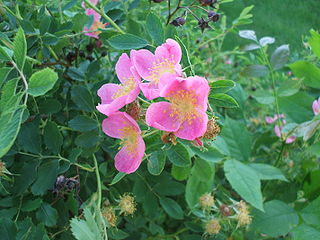
Rosa arkansana, the prairie rose or wild prairie rose, is a species of rose native to a large area of central North America, between the Appalachian and Rocky Mountains from Alberta, Manitoba, and Saskatchewan south to New Mexico, Texas and Indiana. There are two varieties:
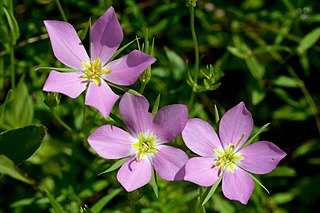
Sabatia campestris is a species of Sabatia, native to the south-central United States, from Texas east to Mississippi and north to Iowa and Illinois. It is also locally naturalized in New England.

Claytonia is a genus of flowering plants native to Asia, North America, and Central America. The vitamin-rich leaves can be eaten raw or cooked, and the tubers can be prepared like potatoes.

Gentianella is a plant genus in the gentian family (Gentianaceae). Plants of this genus are known commonly as dwarf gentians.
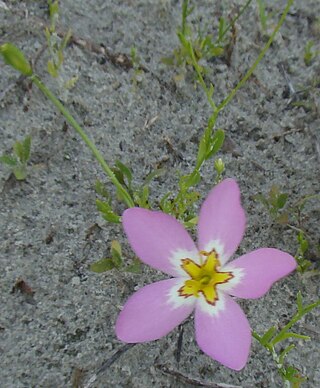
Sabatia stellaris, with the common names rose of Plymouth, marsh pink, salt-marsh pink, and sea-pink; is a species of Sabatia. It has the synonym Sabatia maculata (Benth.) Benth. & Hook.f., Sabatia palmeri Gray, Sabatia purpusii Brandeg., Sabatia simulata Britt.).

Sabatia angularis, commonly called rosepink, rose pink, or rose gentain is a biennial flowering plant in the Gentianaceae (gentain) family. It is native to central and eastern North America.

Echinacea simulata, commonly called wavy leaf purple coneflower, glade coneflower, or prairie purple coneflower, is a species of perennial flowering plant in the family Asteraceae. It is native to the east-central states of the United States. Its natural habitat is dry, calcareous, open areas such as barrens and woodlands.
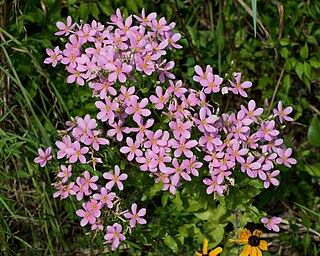
Sabatia, the rose gentians, is a genus of about 20 species of flowering plants in the family Gentianaceae, native to eastern and central North America, Central America, and the Caribbean.
Ulmus boissieriGrudz.,, a disputed species of elm found in Iran, was identified by Grudzinskaya in 1977. She equated her "new species" with the U. campestris f. microphylla collected in 1859 in Kerman Province and described in his Flora Orientalis (1879) by Boissier, for whom she named it, treating Boissier's specimen as the "type". The tree is endemic the provinces of Kermanshah and Kerman., and also the Zagros forests, growing with Quercus brantii, Celtis australis, Platanus orientalis, Fraxinus sp., and Cerasus mahaleb.

Physaria filiformis is a rare species of flowering plant in the family Brassicaceae known by the common names Missouri bladderpod and limestone glade bladderpod. It is native to Missouri and Arkansas in the United States. It was federally listed as an endangered species in 1987 and it was downlisted to threatened status in 2003. P. filiformis remains listed as an endangered species at the state level in Missouri.

Spigelia gentianoides is a rare species of flowering plant in the Loganiaceae known by the common names purpleflower pinkroot and gentian pinkroot. It is native to Alabama and Florida in the United States, where a few small populations remain. It is threatened by the loss and degradation of its habitat, and is a federally listed endangered species of the United States.

Sabatia kennedyana is a species of flowering plant in the gentian family known by the common name Plymouth rose gentian. It is native to eastern North America. It has a disjunct distribution, occurring in Nova Scotia, Massachusetts, Rhode Island, Virginia, North Carolina, and South Carolina.

Echeveria runyonii is a species of flowering plant in the family Crassulaceae, that is native to the state of Tamaulipas in Mexico. Several cultivars have been described and cultivated.

Orphium is a plant genus in the Gentian family (Gentianaceae), endemic to South Africa. The name derives from the legendary Greek musician Orpheus. The genus contains a single accepted species, Orphium frutescens, commonly known as the sea rose. Orphium arenarium C.Presl has been proposed as another species, but data suggest that it is synonymous with Chironia arenaria E.Mey.

Dudleya attenuata is a species of perennial succulent plant known by the common name taper-tip liveforever, native to Baja California and a small portion of California. A rosette-forming leaf succulent, it has narrow pencil shaped leaves that can often be found covered in a white epicuticular wax. The thin, sprawling stems branch to form the clusters of rosettes, with plants creating a "clump" up to 40 cm wide. The small flowers are white or yellow, with 5 spreading petals. It is a diverse, variable species that extends from the southernmost coast of San Diego County to an area slightly north of the Vizcaino Desert, hybridizing with many other species of Dudleya in its range. Some plants with white or pinkish flowers were referred to as Orcutt's liveforever, referring to a former subspecies split on the basis of the flower color.

Sabatia campanulata, commonly known as the slender rose gentian or slender marsh-pink, is an herbaceous plant in the gentian family. It is native to the primarily to the southeastern United States.
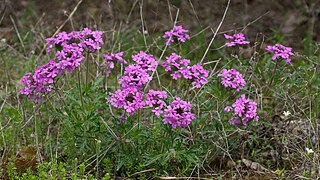
Verbena canadensis, commonly known as rose mock vervain, rose verbena, clump verbena or rose vervain is a perennial herbaceous flowering plant in the verbena family (Verbenaceae) with showy pink to purple flowers.. It is native to the eastern and south-central areas of the United States. This species is widely cultivated as an ornamental, and naturalized populations have been established outside its native range, such as in the northeastern U.S.

Gentiana pannonica, the Hungarian gentian or brown gentian, is a species of flowering plant of the genus Gentiana in the family of Gentianaceae.
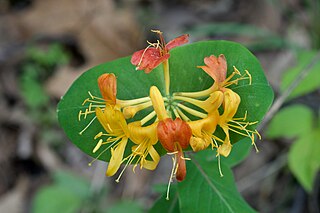
Lonicera flava is a species of honeysuckle native to the central and eastern United States. It is a woody vine with yellow-orange flowers that are slightly fragrant.

Rosa setigera, commonly known as the climbing rose, the prairie rose, or the climbing wild rose, is a shrub or vine in the Rosaceae (rose) family native to central and eastern North America.




















